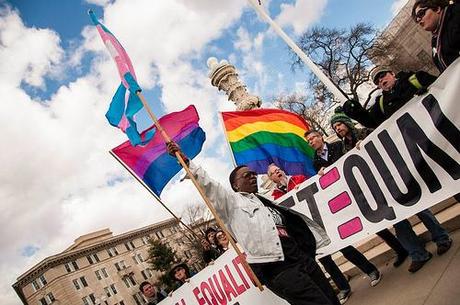Although I’m focussing specifically on bi inclusion here, I’ve tried to be trans*-inclusive within this focus, but would especially welcome corrections or additions to this. I’m not trying to cover ‘quick wins for trans* inclusion’ here, but I am trying to ensure that what I am suggesting about bi inclusion is not trans*-exclusive. And of course other suggestions and comments on anything here are very welcome. What have I missed? Do you agree? What other quick wins might there be?

(cc) Staff Bi Magazine https://www.flickr.com/photos/bimagazine/8621541099
Don’t describe someone as ‘gay’ just because they have a same-sex partner
… because many bisexual people have same-sex partners and don’t describe themselves as ‘gay’. Use the words people use to describe themselves.
This applies to public figures too – Oscar Wilde, Lord Byron, Tom Daley and whoever the latest male politician or sportsman is to have hit the media for having a male lover. Obviously, if they do now describe themselves as gay, then so should you. But if they don’t, then don’t. You could describe them as bisexual or as being attracted to more than one gender or just talk about what has happened without using sexual identity labels. But, best of all, use whatever words they use to describe themselves.
Don’t say ‘gay and straight relationships’ or ‘same-sex and heterosexual relationships’
… because that excludes people in bisexual relationships. Depending on what you actually mean, try ‘all types of relationships’ or ‘LGB and heterosexual’ or, to some audiences, ‘queer and straight’. You might try ‘same-sex and different-sex relationships’, if that’s the distinction you’re really interested in, but that isn’t very trans*-inclusive, because it implies that two people are either the same or different sexes, and sex can be more complicated than that.
Bisexual people in different-sex relationships are not ‘in a heterosexual relationship’ because they are not heterosexual. A heterosexual relationship is something that heterosexual people have. Well, subject to the point above about using people’s own terminology – if bisexual people in a different-sex relationship do want to describe their relationship as heterosexual, then of course they can, but don’t impose that label on them.
Don’t use ‘gay’ as a shorthand for LGB or LGB&T
… because most bisexual people don’t think of themselves as gay – if you say ‘gay’ they feel excluded. ‘Gay’ as a shorthand to include trans* people really doesn’t work well. And some lesbians really don’t like it either. In more formal writing, such as policy reports and research findings, it’s easy enough to avoid using ‘gay’ in this way - just use LGB or LGB&T or LGBTIQQA or any other such acronym that is appropriate to your context. In speech and some types of media it can be harder to find replacements for ‘gay’ as a shorthand. ‘Queer’ works in some contexts. ‘Non-heterosexual’ works in others.
Don’t forget biphobia (and transphobia)
… because while bisexual people may experience homophobia, they also experience biphobia too. Try ‘homophobia and biphobia’ or ‘homophobia, biphobia and transphobia’. Or, depending on the context, ‘hate crimes against LGBT people’.
There’s more discussion of biphobia and how it differs from homophobia here.
Don’t say you talked to ‘LGB&T people’ if you only talked to lesbians and gay men
… because that suggests that LGB&T people really means lesbians and gay men. Say ‘lesbians and gay men’ if that is who you talked to.
If you had hoped to talk to B and T people as well, but not managed to do so in the end, you could say that. But the fact that you know that there is more to LGB&T than L and G doesn’t make it legitimate to generalise from L and G to LGB&T.
Don’t always subdivide your group of LGB people by gender (e.g. ‘lesbians and bisexual women’ versus ‘gay and bisexual men’)
… because that erases bisexuality by making it sound as if gender is always the most the important difference between LG and B people. Try looking at the bisexual women and bisexual men together as one category. Or see whether some other subdivision, such as race/ethnicity, age or social class is more important.
